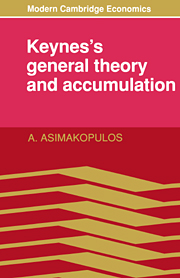6 results in Modern Cambridge Economics Series

The Evolution of Economic Ideas
-
- Published online:
- 05 June 2012
- Print publication:
- 05 October 1978

Fiscal and Monetary Policies and Problems in Developing Countries
-
- Published online:
- 01 June 2011
- Print publication:
- 12 January 1984

Money, Interest and Capital
- A Study in the Foundations of Monetary Theory
-
- Published online:
- 04 April 2011
- Print publication:
- 11 May 1989

Keynes's General Theory and Accumulation
-
- Published online:
- 24 October 2009
- Print publication:
- 28 June 1991

Capitalist Development in the Twentieth Century
- An Evolutionary-Keynesian Analysis
-
- Published online:
- 22 September 2009
- Print publication:
- 12 July 2001

Post Keynesian Price Theory
-
- Published online:
- 22 September 2009
- Print publication:
- 04 February 1999

